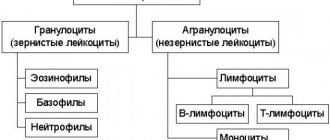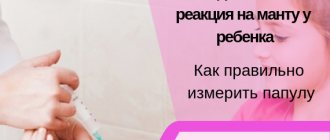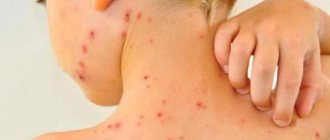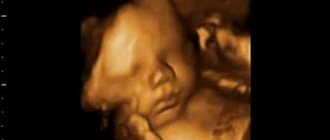Parents often ask their pediatrician the question - how serious is the need to perform the Mantoux test for children ? A little history to understand the essence of the procedure. In 1890, the discoverer of the causative agent of tuberculosis, Robert Koch, developed a drug called tuberculin. Koch planned to treat tuberculosis using tuberculin.
In 1907, Pirquet first used the drug to diagnose tuberculosis. To carry out the procedure, a small area of skin was specially damaged. Later, the Frenchman Mantoux (Mantoux) in 1908 developed a technique for intradermal injection of tuberculin. Since then, the procedure has been called the Mantoux test.
Why is Mantoux vaccinated for children?
Mantoux is made to identify Koch bacilli in the body.
The manipulation also makes it possible to determine the presence (absence) of the baby’s immunity to the causative agents of tuberculosis disease. Pediatricians prescribe the Mantoux test to identify among children:
- recent carriers of Koch's bacillus;
- infected for more than a year;
- persons who need revaccination against tuberculosis.
This information is necessary in order to confirm or refute the diagnosis and prevent the development of a disease or epidemic. The test is required for the timely detection of Koch bacilli in the body and taking certain measures to successfully cure the pathology.
Some parents think that Mantoux is a vaccine. But this is an erroneous opinion: the introduction of tuberculin into the blood does not develop specific immunity against Koch's bacillus. This is the usual method for diagnosing the disease.
Until what age is it done?
The first Mantoux sample is made per year. It makes no sense to perform the analysis earlier, since the baby’s immune system is still at the stage of formation and the test results will be false. The plan provides for the first administration of tuberculin at 12 months. Further, the check is performed annually, at approximately the same time.
If indicated, testing is carried out more often. If the test gives a positive result, someone close to you is sick with tuberculosis, then Mantu is done 2-3 times a year. This diagnosis is indicated upon reaching 15 years of age. For adults, the test is carried out if there is a suspicion of the presence of Koch's bacillus in the body.
Hyperergic test
A hyperergic reaction occurs when there is excessive immune activation of the human body. This is a variant of deviation, which is often accompanied not only by the occurrence of infiltration, but also by the development of vesicles, inflammation of regional lymph nodes, and foci of necrosis in the area of tuberculin injection.
Most often, this version of the Mantoux test is observed during an active tuberculosis process in the body. In this case, clinical symptoms of the disease can be detected in the child (prolonged cough, low-grade body temperature, general weakness, weight loss).
In this case, the child is sent for consultation to a specialized medical institution, where a bacteriological analysis of sputum, chest radiography, and a set of laboratory tests are performed. After diagnosis, a course of combination chemotherapy is prescribed.
Preparation for Mantoux vaccination at 1-2 years
As a rule, the Mantoux test is well tolerated.
But in order to minimize the risk of feeling unwell after the test and get a reliable result, you should prepare for the analysis in a certain way.
The child's body is sensitive to various drugs.
This is especially true for children aged 1 to 2 years. Therefore, parents should check with their pediatrician about the rules for preparing for Mantoux.
Experts recommend the following:
- If a child is prone to allergies, this must be indicated in the form that is filled out before the test.
- It is important to inform doctors about all infectious pathologies previously suffered by the baby and about existing chronic diseases.
- A couple of days before testing, do not walk with your child in crowded places (shops, parks, playgrounds).
- When going for manipulation, dress the baby in clothes made from natural fabrics with loose sleeves.
- For five days before the injection and for three days after, do not change your usual diet. But, if there are allergenic foods on the menu, it is better to exclude them: after Mantoux, the child’s body becomes weaker.
- Hypersensitive individuals should enrich their diet with calcium-containing foods, which reduce the risk of developing an allergic reaction.
- On the eve of the diagnosis, it is necessary to provide the baby with peace so that he gets a good night's sleep and rest.
- If your child is constipated, you should give him an enema.
- Study the vaccination card. The Mantoux test is allowed to be done no less than a month after the last vaccination.
- On the day of the test, it is worth measuring the child’s body temperature.
Reaction mechanism and papule size
To detect Koch bacilli in the body, a product containing tuberculin is used. This substance is obtained from killed tuberculosis bacteria. The drug is injected subcutaneously into the middle part of the forearm.
A response occurs on the epidermis in the injection area, which indicates the presence of Koch bacilli.
If a papule has formed, this means that the body has already encountered the tuberculosis pathogen. The absence of a trace indicates a negative reaction and the need for BCG revaccination.
The reaction to the test is assessed three days after the tuberculin injection. To do this, the doctor measures the diameter of the papule with a ruler and correlates the result with the norm.
A breakdown of the size of the formation is given below:
- The diameter of the papule does not exceed a millimeter, there is no redness - the reaction is negative.
- The size of the formation varies from 2 to 4 mm - a questionable response to the test.
- The size of the papule is 5-16 mm – the reaction is positive.
- A mark with a diameter greater than 1.7 cm is a hyperergic response.
It is impossible to say 100% based on the Mantoux results that a person is sick or healthy. The reaction shows the presence of Koch bacilli in the body, which can lead to the development of tuberculosis only when conditions suitable for this arise.
A negative reaction to Mantoux is considered normal. A questionable option may be the norm in the absence of a threat of infection (when the child is in regions with a high incidence of tuberculosis or is in contact with a patient with an open form of this pathology). A positive reaction should not frighten parents: it is likely that they were recently vaccinated or suffered an infection or allergy. Tuberculosis can be excluded by fluorographic, x-ray examination, and sputum culture analysis. Then the baby should be brought to an appointment with a TB doctor. If necessary, the doctor will select a treatment regimen.
Tuberculin causes only a local reaction and does not affect the general health of the child. It is impossible to become infected after the Mantoux test, since the drug does not contain live bacteria.
Correctness of assessment
Parents are often interested in what size Mantoux is considered normal for children. When measuring a sample at home, they may make some mistakes and get some scary results. The medical specialist uses a tuberculin ruler, which is completely transparent. It is applied to the arm along the line where the puncture site is located. Sometimes you can evaluate the result visually. We are talking about cases when it is already obvious that the “button” is tiny.
If there is still a need to use a special ruler, the doctor measures only the location of the lump, without touching the reddened area. Unfortunately, there are now frequent cases where false positive results are observed. The most common mistake is not taking into account the baby’s age. The younger the child, the larger the diameter the lump can reach after the injection
It is important that as you grow older, the size of the papule decreases
If you see a large compaction after Mantoux, you should not panic. It is possible that this is an allergic reaction to tuberculin. If the diameter is really large, then most likely you will have to undergo repeated tests. Final conclusions are made only after several samples.
There may be many reasons for Mantoux’s positive reaction. One of them is poor ecology. Toxic emissions from enterprises poison the body, which provokes local inflammation. It is they who can cause a pronounced positive reaction and frighten parents.
Wanting to understand how many millimeters is the Mantoux norm for 1 year, adults should ask their doctor about this or look at a special table. You should not worry too much about large sizes until repeated studies have been completed.
Contraindications and complications
Mantoux allows you to timely detect infection with Koch bacilli. But in some cases this test is postponed or not performed at all.
Contraindications to tuberculin injection are:
- acute or chronic epidermal pathologies;
- infectious diseases;
- epilepsy;
- allergy;
- brain damage;
- rheumatism;
- cold;
- severe neurological diseases of a congenital or acquired nature;
- bronchial asthma.
If you do Mantoux in such cases, the risk of side effects increases.
As a rule, the tuberculin test is well tolerated by children of all age categories. Negative consequences occur extremely rarely and are represented by the following symptoms:
- increased body temperature;
- allergic reaction;
- loss of consciousness;
- loss of appetite.
Such manifestations usually subside a few days after the subcutaneous injection. You can give your baby an antipyretic or an antihistamine (depending on the situation). If your health continues to deteriorate, you should seek medical help.
To ensure that the Mantoux test does not cause complications, you should adhere to the following rules:
- On the eve of the procedure, exclude allergenic foods from your diet.
- Diversify the menu with calcium-containing products.
- If your baby has a tendency to allergies, you should give him an antihistamine on the day of the injection.
- If the baby has a high temperature and is not feeling well, refuse to carry out the manipulation.
- Tell your child how to handle the injection site, make sure that he does not wet, scratch or rub the injection area.
The pediatrician tells parents and the child in detail about how to prepare for the Mantoux test and how to behave after it before the manipulation.
Do children need tuberculin diagnostics - doctors’ opinion
Doctors' opinions differ regarding whether children need tuberculin diagnostics. Some doctors oppose Mantoux. They focus on the fact that the drug contains Tween-80 and phenol, which negatively affect health. Experts also warn that tuberculin can provoke an allergic reaction in sensitive individuals. The risk of complications increases especially when the test is repeated.
Doctors include the following negative aspects of Mantoux:
- Risk of receiving false results.
- Damage to the genetic apparatus.
- Disturbance in the functioning of the genital organs.
- The likelihood of developing a severe allergic reaction. Anaphylaxis can be fatal.
- Risk of developing idiopathic thrombocytopenic purpura. This is a dangerous blood pathology, which is characterized by a sharp decrease in platelet levels in the serum. If timely medical assistance is not provided, a cerebral hemorrhage will occur and the person will die. Fortunately, such a reaction is extremely rare.
But most doctors still insist on performing the Mantoux test, arguing that this diagnostic method is safe and, subject to all preparation rules, proceeds without complications.
Thus, the Mantoux test is performed on children from one year of age to 15 years. It allows you to detect tuberculosis at an early stage. The analysis rarely causes side effects and usually shows reliable results.
"Test turn"
In phthisiology there is also such a term as “Mantoux test turn”. When is it used? Usually the Mantoux test is performed on a child every year, its results are recorded in the medical documentation, and attention is paid to the dynamics. If, against the background of a trend towards decreasing indicators, a dubious or negative reaction, a sharp increase in formation (more than 6 mm) suddenly occurs, this is a turn.
Most often, this indicates that the child is infected with Mycobacterium tuberculosis. That is why it needs to be further examined in order to interrupt a possible active process. For this, the child is referred to a TB specialist. In most cases, the body copes with the pathogen on its own and no signs of tuberculosis can be detected. However, in some cases this is how this dangerous disease is detected.











